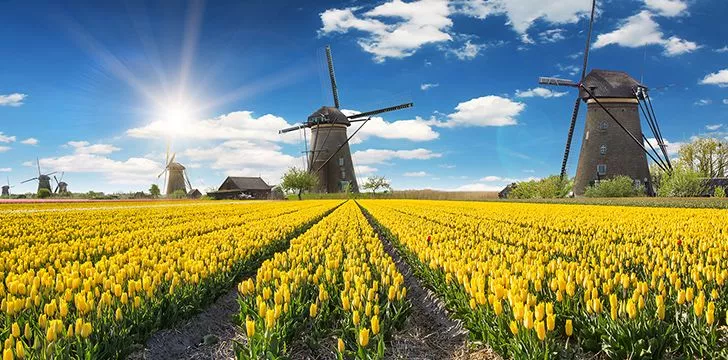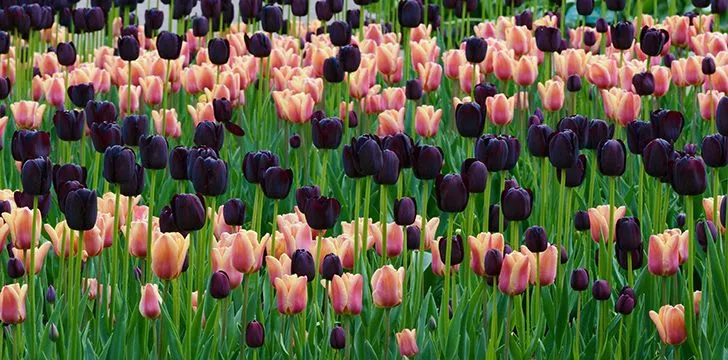Did you know that tulips did not originate from the Netherlands? In fact, they first came from Turkey!
Tulips are my wife’s favorite flowers, and if I had to choose, they would probably be mine too! Part of the Lily family, these unique little flowers represent spring and the upcoming summer season, but also have different meanings for their various colors.
Although closely associated with the Netherlands, tulips are not native to Eastern Europe. They were imported from the Middle East and first cultivated by Flemish botanist Carolus Clusius at the botanical gardens of Dutch Leiden University.
Did you know that tulips are edible? Or that they are the national flowers of Turkey and Afghanistan? And did you know that tulips helped save the Netherlands from starvation during World War II?
Well, all of this and more will be covered in these 5 fun facts about tulips…
Tulips did not originate from the Netherlands.

Despite being the national flower of the Netherlands, tulips are not native to the country. They originally grew across Southern Europe to Central Asia and were imported to Eastern Europe from what is now Turkey.
The tulip became a highly coveted prize in the Netherlands because of its vibrant and lush color, which was not found in the native flowers of the region. Tulips became a status symbol for the Dutch and contributed to one of the world’s first economic bubbles, known as “Tulipmania,” where tulips were so valuable that they could be used to buy a house!
Today, the Netherlands remains the world’s largest producer of tulips, producing 3 billion bulbs annually, most of which are exported worldwide.
The word “tulip” comes from the word “turban.”

In the Middle East, tulips were called “dulband,” which is Persian for “turban,” because the way the flower’s head sat on its stem resembled a turban on a person’s head.
However, it is possible that this is untrue because during that time, it was fashionable to wear tulips in one’s turban. So, nobody really knows if they were named after turbans or because of their shape!
“Dulband” in Persian became “Tülbent” in Turkish, which evolved into “Tulipán” in Danish, all of which meant “turban,” but later became “Tulipe” in French, which simply meant “tulip.” That’s where the word “tulip” comes from!
There are over 3,000 different varieties of tulip!

This is no surprise for anyone who has ever taken a stroll through Amsterdam’s famous floating flower market! With 75 wild tulip species and over 150 different species in total, it’s no wonder there are so many variations.
There are even tulips that bloom with up to four different flower heads on a single stem! Some of the most striking tulips have streaks of different colors in their petals.
Flemish botanist Carolus Clusius is credited with cultivating the original tulips in the Netherlands during the 1600s. He discovered that some of the tulips he grew had a viral infection that caused their petals to display striking streaks of color, which he dubbed “broken tulips.” After carefully spreading the infection among his tulips, Clusius succeeded in creating many new color variations. Tulips come in over 3,000 different variations and each color holds a different meaning. Red tulips represent true love, yellow tulips represent hope and cheerful thoughts, white tulips are used for apologies, and purple tulips symbolize royalty. Tulips are also edible – the petals can be eaten raw and the bulbs can be eaten if properly prepared. During the Hunger Winter famine of 1944, the Dutch government published a guide on how to prepare tulip bulbs as food, and many people survived by eating them. Sweden eventually sent food to the Netherlands, and the famine ended in 1945. Once again, tulips played a significant role in Dutch history.
FAQ
1. What is the history of tulips?
Tulips have a rich history dating back to the Ottoman Empire in the 16th century. They were first cultivated in Turkey and quickly gained popularity throughout Europe, especially in the Netherlands. In the 17th century, the demand for tulips in the Netherlands reached a fever pitch and led to a speculative market known as “Tulip Mania.” Today, tulips are still one of the most popular flowers in the world.
2. What are the different colors of tulips?
Tulips come in a wide range of colors, including red, pink, yellow, orange, purple, white, and even bi-color varieties. Each color has its own meaning, with red tulips symbolizing love and yellow tulips representing friendship. Pink tulips are often associated with happiness and joy, while purple tulips are a symbol of royalty and elegance.
3. How do you care for tulips?
To care for tulips, it is important to plant them in well-drained soil in a location that receives full sun or partial shade. Water them regularly, but be careful not to overwater as this can lead to root rot. After the tulips have finished blooming, allow the foliage to wither and die back naturally before removing it. This allows the bulb to store energy for the following year’s bloom.
4. When is the best time to plant tulips?
The best time to plant tulips is in the fall, typically between September and November. This allows the bulbs to establish roots before the ground freezes and ensures a beautiful spring bloom. It is important to plant tulips at the correct depth, typically 6-8 inches deep depending on the size of the bulb.
5. What are some popular tulip festivals?
Tulip festivals are held all over the world to celebrate the beauty and diversity of these stunning flowers. The most famous of these festivals is the Keukenhof Gardens in the Netherlands, which features over 7 million tulips each year. Other popular festivals include the Skagit Valley Tulip Festival in Washington State, the Tulip Time Festival in Holland, Michigan, and the Canadian Tulip Festival in Ottawa, Ontario.

Zayn Anderson is a prolific writer with a passion for uncovering the world’s intriguing facts. Armed with an insatiable curiosity, he delves into various subjects, from history and science to nature and technology.
